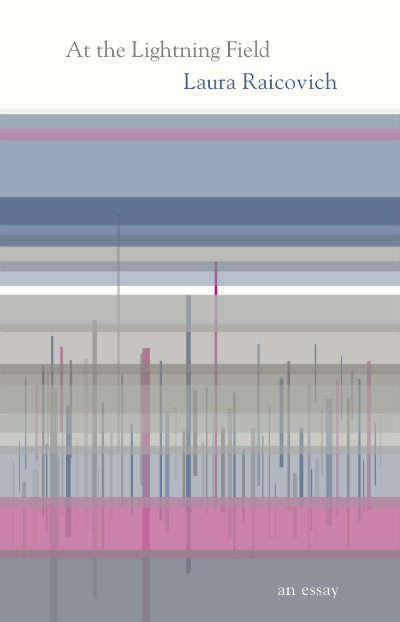
How does one properly capture a work of art using only words on a page? If the artwork in question is a painting or sculpture that can be easily walked around and observes from a host of angles, the task becomes more plausible. There’s a way to describe the way a work is arranged, the craft of brushstrokes or molded material, the sensation of proximity. What happens, though, when the work of art is something more vast? What happens when a landscape is also a work of art?
Such is the case with Walter De Maria’s The Lightning Field, located in the middle of New Mexico. Laura Raicovich’s book-length essay At the Lightning Field is an attempt to rise to this challenge–an experimental and format-breaking work of prose that meets De Maria’s work halfway. From the earliest moments, she lays out a crystal-clear description of the space she’ll be exploring: “four hundred stainless steel polls positioned 220 feet apart,” located in a flat and isolated region of the state.
This book isn’t a work of criticism: in the opening pages, Raicovich states that she worked at the Dia Art Foundation, which maintains The Lightning Field, for the better part of a decade. (She’s now the executive director of the Queens Museum.) But this book is also not an insider’s look at a particularly well-known piece of art created late in the twentieth century. Instead, it’s both a testament to the effects of art on the mind and a formally inventive way of conveying certain aspects of De Maria’s work.
Over the course of the book, Raicovich writes about several visits to the sculpture. She uses matter-of-fact language about the details of these trips–who accompanied her, who else was staying at the cabin near The Lightning Field, and what she hoped to get from those experiences. But she also juxtaposes that with a freer use of language that approaches free verse.
The clouds were moving fast,
shadow and sun alternating above as we drove.
Throughout the book, Raicovich brings together disparate elements from across artistic and scientific disciplines. She delves into the history and construction of The Lightning Field, the mathematical theories of Benoit Mandelbrot, and Edward Lorenz’s work on weather–then throws some Belle and Sebastian lyrics in for good measure. Also in the mix are quotations from the likes of Anne Carson and Boris Pasternak, which punctuate the narrative. The end result is an essay that feels experimental and experiential.
That’s likely the point. Early in the book, Raicovich writes, “The Lightning Field defines a particular organization of space, experience, time, and light. The artwork permanent, the experience variable.” And while it would be stretching things to say that this book translates De Maria’s artwork into words on a page–a decidedly impossible task–it does an excellent job of evoking the complex web of associations that art of that nature commands. The result is a surprising, nimble look at a notable work of art, as evocative and unpredictable as the most thought-provokingly conceptual works can be.
***
At the Lightning Field
by Laura Raicovich
Coffee House Press; 104 p.
Follow Vol. 1 Brooklyn on Twitter, Facebook, and sign up for our mailing list.
